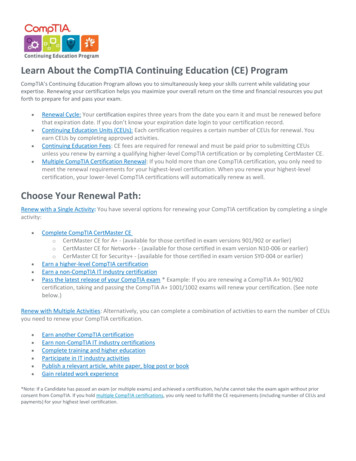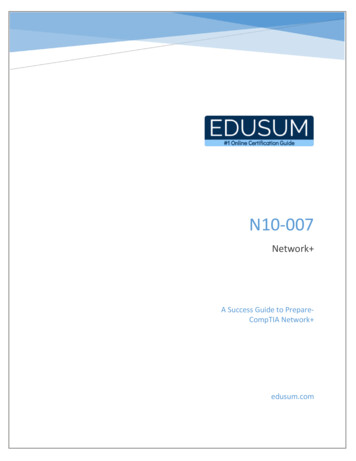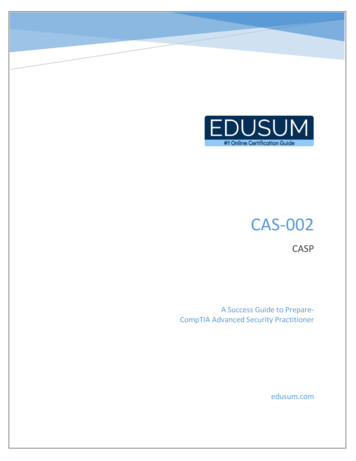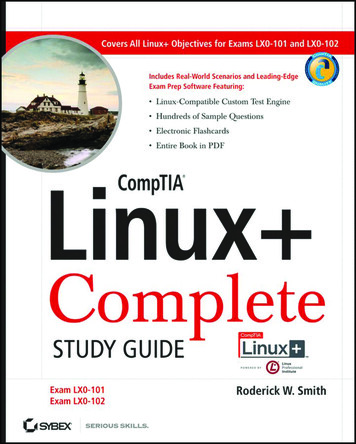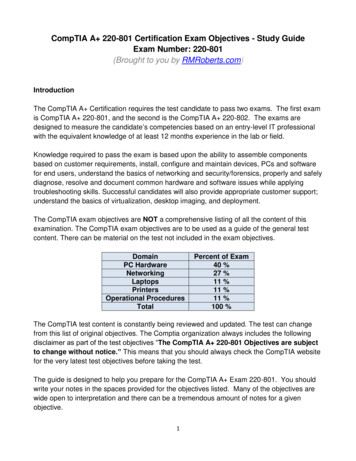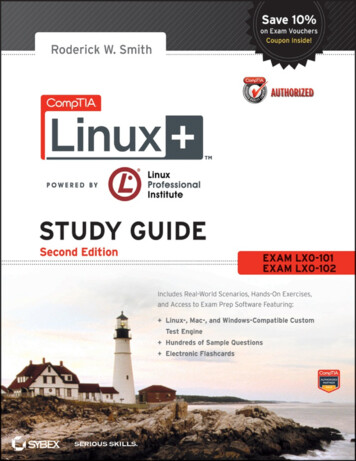
Transcription
ContentsAcknowledgmentsAbout the AuthorTable of ExercisesCompTIA CertificationIntroductionThe Exam ObjectivesAssessment TestAnswers to the Assessment TestPart I: Exam 1Chapter 1: Exploring Linux Command-Line ToolsUnderstanding Command-Line BasicsUsing Streams, Redirection, and PipesProcessing Text Using FiltersUsing Regular ExpressionsSummaryExam EssentialsReview QuestionsChapter 2: Managing SoftwarePackage ConceptsUsing RPMUsing Debian Packages
Converting Between Package FormatsPackage Dependencies and ConflictsManaging Shared LibrariesManaging ProcessesSummaryExam EssentialsReview QuestionsChapter 3: Configuring HardwareConfiguring the Firmware and Core HardwareConfiguring Expansion CardsConfiguring USB DevicesConfiguring Hard DisksDesigning a Hard Disk LayoutCreating Partitions and FilesystemsMaintaining Filesystem HealthMounting and Unmounting FilesystemsSummaryExam EssentialsReview QuestionsChapter 4: Managing FilesUsing File Management CommandsManaging File OwnershipControlling Access to FilesManaging Disk QuotasLocating FilesSummaryExam EssentialsReview Questions
Chapter 5: Booting Linux and Editing FilesInstalling Boot LoadersUnderstanding the Boot ProcessDealing with Runlevels and the Initialization ProcessUsing Alternative Boot SystemsEditing Files with ViSummaryExam EssentialsReview QuestionsPart II: Exam 2Chapter 6: Configuring the X Window System, Localization, andPrintingConfiguring Basic X FeaturesConfiguring X FontsManaging GUI LoginsUsing X for Remote AccessX AccessibilityConfiguring Localization and InternationalizationConfiguring PrintingSummaryExam EssentialsReview QuestionsChapter 7: Administering the SystemManaging Users and GroupsTuning User and System EnvironmentsUsing System Log FilesMaintaining the System Time
Running Jobs in the FutureSummaryExam EssentialsReview QuestionsChapter 8: Configuring Basic NetworkingUnderstanding TCP/IP NetworkingUnderstanding Network AddressingConfiguring Linux for a Local NetworkDiagnosing Network ConnectionsSummaryExam EssentialsReview QuestionsChapter 9: Writing Scripts, Configuring Email, and Using DatabasesManaging the Shell EnvironmentWriting ScriptsManaging EmailManaging Data with SQLSummaryExam EssentialsReview QuestionsChapter 10: Securing Your SystemAdministering Network SecurityAdministering Local SecurityConfiguring SSHUsing GPGSummaryExam Essentials
Review QuestionsAppendix A: Answers to Review QuestionsAppendix B: About the Additional Study ToolsIndexAdvertisements
Senior Acquisitions Editor: Jeff KellumDevelopment Editor: Alexa MurphyTechnical Editors: Ross Brunson and Kevin Glendenning, FOSSter.comProduction Editor: Eric CharbonneauCopy Editor: Kim WimpsettEditorial Manager: Pete GaughanProduction Manager: Tim TateVice President and Executive Group Publisher: Richard SwadleyVice President and Publisher: Neil EddeMedia Project Manager 1: Laura Moss-HollisterMedia Associate Producer: Marilyn HummelMedia Quality Assurance: Josh FrankBook Designer: Judy FungProofreader: Candace CunninghamIndexer: Ted LauxProject Coordinator, Cover: Katherine CrockerCover Designer: Ryan SneedCopyright 2013 by John Wiley & Sons, Inc., Indianapolis, IndianaPublished simultaneously in CanadaISBN: 978-1-118-53174-7ISBN: 978-1-118-61130-2 (ebk.)ISBN: 978-1-118-57034-0 (ebk.)ISBN: 978-1-118-57048-7 (ebk.)No part of this publication may be reproduced, stored in a retrieval system or transmitted in any formor by any means, electronic, mechanical, photocopying, recording, scanning or otherwise, except aspermitted under Sections 107 or 108 of the 1976 United States Copyright Act, without either the priorwritten permission of the Publisher, or authorization through payment of the appropriate per-copy feeto the Copyright Clearance Center, 222 Rosewood Drive, Danvers, MA 01923, (978) 750-8400, fax(978) 646-8600. Requests to the Publisher for permission should be addressed to the PermissionsDepartment, John Wiley & Sons, Inc., 111 River Street, Hoboken, NJ 07030, (201) 748-6011, fax(201) 748-6008, or online at www.wiley.com/go/permissions.Limit of Liability/Disclaimer of Warranty: The publisher and the author make no representations orwarranties with respect to the accuracy or completeness of the contents of this work and specificallydisclaim all warranties, including without limitation warranties of fitness for a particular purpose. Nowarranty may be created or extended by sales or promotional materials. The advice and strategies
contained herein may not be suitable for every situation. This work is sold with the understanding thatthe publisher is not engaged in rendering legal, accounting, or other professional services. Ifprofessional assistance is required, the services of a competent professional person should be sought.Neither the publisher nor the author shall be liable for damages arising herefrom. The fact that anorganization or Web site is referred to in this work as a citation and/or a potential source of furtherinformation does not mean that the author or the publisher endorses the information the organization orWeb site may provide or recommendations it may make. Further, readers should be aware thatInternet Web sites listed in this work may have changed or disappeared between when this work waswritten and when it is read.For general information on our other products and services or to obtain technical support, pleasecontact our Customer Care Department within the U.S. at (877) 762-2974, outside the U.S. at (317)572-3993 or fax (317) 572-4002.Wiley publishes in a variety of print and electronic formats and by print-on-demand. Some materialincluded with standard print versions of this book may not be included in e-books or in print-ondemand. If this book refers to media such as a CD or DVD that is not included in the version youpurchased, you may download this material at http://booksupport.wiley.com. For more informationabout Wiley products, visit www.wiley.com.Library of Congress Control Number: 2012951868TRADEMARKS: Wiley, the Wiley logo, and the Sybex logo are trademarks or registered trademarksof John Wiley & Sons, Inc. and/or its affiliates, in the United States and other countries, and may notbe used without written permission. CompTIA and Linux are trademarks or registered trademarksof Computing Technology Industry Association, Inc. All other trademarks are the property of theirrespective owners. John Wiley & Sons, Inc. is not associated with any product or vendor mentionedin this book.
Dear Reader,Thank you for choosing CompTIA Linux Study Guide, Second Edition. This book is part of afamily of premium-quality Sybex books, all of which are written by outstanding authors who combinepractical experience with a gift for teaching.Sybex was founded in 1976. More than 30 years later, we’re still committed to producingconsistently exceptional books. With each of our titles, we’re working hard to set a new standard forthe industry. From the paper we print on to the authors we work with, our goal is to bring you the bestbooks available.I hope you see all that reflected in these pages. I’d be very interested to hear your comments and getyour feedback on how we’re doing. Feel free to let me know what you think about this or any otherSybex book by sending me an email at nedde@wiley.com. If you think you’ve found a technical errorin this book, please visit http://sybex.custhelp.com. Customer feedback is critical to our efforts atSybex.Best regards,Neil EddeVice President and PublisherSybex, an Imprint of Wiley
AcknowledgmentsAlthough this book bears my name as author, many other people contributed to its creation. Withouttheir help, this book wouldn’t exist, or at best would exist in a lesser form. Jeff Kellum was theacquisitions editor and so helped get the book started. Alexa Murphy, the developmental editor, andEric Charbonneau, the production editor, oversaw the book as it progressed through all its stages.Ross Brunson and Kevin Glendenning were the technical editors who checked the text for technicalerrors and omissions—but any mistakes that remain are my own. Kim Wimpsett, the copy editor,helped keep the text grammatical and understandable. The proofreader, Candace Cunningham,checked the text for typos. I’d also like to thank Neil Salkind and others at Studio B, who helpedconnect me with Wiley to write this book.
About the AuthorRoderick W. Smith is a Linux consultant and author. He has written more than 20 books on Linux,FreeBSD, and computer networking, including Linux Essentials, the LPIC-2 Study Guide, and LinuxAdministrator Street Smarts (all from Sybex). He can be reached at rodsmith@rodsbooks.com.
Table of ExercisesExercise 1.1 Editing CommandsExercise 2.1 Managing Packages Using RPMExercise 2.2 Managing Debian PackagesExercise 3.1 Creating FilesystemsExercise 4.1 Modifying Ownership and PermissionsExercise 4.2 Locating FilesExercise 5.1 Changing RunlevelsExercise 6.1 Printing with LinuxExercise 7.1 Creating User AccountsExercise 7.2 Creating User cron JobsExercise 8.1 Practice Resolving HostnamesExercise 8.2 Configuring a Network ConnectionExercise 9.1 Changing Your bash PromptExercise 9.2 Creating a Simple ScriptExercise 9.3 Creating a SQL DatabaseExercise 10.1Monitor Network Port Use
CompTIA CertificationIt Pays to Get CertifiedIn a digital world, digital literacy is an essential survival skill. Certification proves you have theknowledge and skill to solve business problems in virtually any business environment. Certificationsare highly valued credentials that qualify you for jobs, increased compensation, and promotion.Certification Helps Your CareerCompTIA Linux Powered by LPI certification is held by many IT staff members in organizations—25 percent of IT staff within a random sampling of U.S. organizations within a cross section ofindustry verticals have earned CompTIA Linux certification.CompTIA Linux Powered by LPI Validates the fundamental knowledge andskills required of junior Linux administrators. The exams cover system architecture, GNU and UNIXcommands, user interfaces and desktops, and Linux installation and package management.Candidate Job Roles Includes junior Linux administrator, junior network administrator, systemsadministrator, Linux database administrator, and web administrator.Dual Certification If you choose, certification in CompTIA Linux Powered by LPI, attained bypassing CompTIA exams LX0-101 and LX0-102, enables you to become certified in LPIC-1 as well.Starting Salary The average salary for CompTIA Linux Powered by LPI certification holders is 76,000 (USD).Mandated/Recommended by Organizations Worldwide Companies such as Dell, HP, IBM,
Lenovo, and Xerox recommend or require CompTIA Linux Certification.CompTIA Career PathwayCompTIA offers a number of credentials that form a foundation for your career in technology andallow you to pursue specific areas of concentration. Depending on the path you choose to take,CompTIA certifications help you build upon your skills and knowledge, supporting learningthroughout your entire career.Steps to CertificationFour Steps to Getting Certified and Staying Certified1. Review theexam objectives.2. Practice forthe exam.3. Purchase anexam voucher.4. Take the test!Review the certification objectives to make sure you know what is covered on the p/examobjectives.aspx.After you have studied for the certification, take a free assessment and sample test to get an idea what type ofquestions might be on the exam: cticetests.aspx.Purchase exam vouchers on the CompTIA Marketplace, which is located at http://www.comptiastore.com.Select a certification exam provider and schedule a time to take your exam. You can find exam providers p/testingcenters.aspx.
Join the Professional CommunityThe free IT Pro online community (http://itpro.comptia.org) provides valuable content to students andprofessionals.Career IT job resourcesWhere to start in ITCareer assessmentsSalary trendsU.S. job boardForums on networking, security, computing, and cutting-edge technologiesAccess to blogs written by industry expertsCurrent information on cutting-edge technologiesAccess to various industry resource links and articles related to IT and IT careersContent Seal of QualityThis courseware bears the seal of CompTIA Approved Quality Content. This sealsignifies this content covers 100 percent of the exam objectives and implements importantinstructional design principles. CompTIA recommends multiple learning tools to help increasecoverage of the learning objectives.Why CompTIA?Global Recognition CompTIA is recognized globally as the leading IT nonprofit trade associationand has enormous credibility. Plus, CompTIA’s certifications are vendor-neutral and offer proof offoundational knowledge that translates across technologies.Valued by Hiring Managers Hiring managers value CompTIA certification because it is a vendorand technology-independent validation of your technical skills.Recommended or Required by Government and Businesses Many government organizations andcorporations either recommend or require technical staff to be CompTIA certified (for example, Dell,Sharp, Ricoh, the U.S. Department of Defense, and many more).Three CompTIA Certifications Ranked in the Top 10 In a study by DICE of 17,000 technologyprofessionals, certifications helped command higher salaries at all experience levels.How to Obtain More InformationVisit CompTIA online Visit http://www.comptia.org to learn more about getting CompTIA certified.Contact CompTIA Call 866-835-8020 ext. 5 or email questions@comptia.org.Join the IT Pro Community Visit http://itpro.comptia.org to join the IT Pro community to getrelevant career information.Connect with Us Learn more about us via LinkedIn, Facebook, Twitter, Flickr, and YouTube.
IntroductionWhy should you learn about Linux? It’s a fast-growing operating system, and it is inexpensive andflexible. Linux is also a major player in the small and mid-sized server field, and it’s an increasinglyviable platform for workstation and desktop use as well. By understanding Linux, you’ll increaseyour standing in the job market. Even if you already know Windows or Mac OS and your employeruses these systems exclusively, understanding Linux will give you an edge when you’re looking for anew job or you’re looking for a promotion. For instance, this knowledge will help you to make aninformed decision about if and when you should deploy Linux. The Computing Technology IndustryAssociation (CompTIA) promotes the Linux exam as an introductory certification for people whowant to enter careers involving Linux. The exam is meant to certify that an individual has the skillsnecessary to install, operate, and troubleshoot a Linux system and is familiar with Linux-specificconcepts and basic hardware.The purpose of this book is to help you pass the Linux exams (LX0-101 and LX0-102) updated in2012. Because these exams cover basic Linux installation, configuration, maintenance, applications,networking, and security, those are the topics that are emphasized in this book. You’ll learn enough toget a Linux system up and running and to configure it for many common tasks. Even after you’ve takenand passed the Linux exams, this book should remain a useful reference.In 2010, CompTIA announced a partnership with Linux Professional Institute, theorganization behind the popular LPI Certification (LPIC) program. With this partnership,CompTIA offers the LPIC Level 1 exams under the Linux umbrella. The exams and theexam objectives are identical for the two programs; however, Linux candidates have theoption of receiving their LPIC-1 as well as the Novell Certified Linux Administratorcertification by passing the CompTIA Linux exams.What Is Linux?Linux is a clone of the Unix operating system (OS) that has been popular in academia and manybusiness environments for years. Formerly used exclusively on large mainframes, Unix and Linux cannow run on small computers—which are actually far more powerful than the mainframes of just a fewyears ago. Because of its mainframe heritage, Unix (and hence also Linux) scales well to performtoday’s demanding scientific, engineering, and network server tasks.Linux consists of a kernel, which is the core control software, and many libraries and utilities thatrely on the kernel to provide features with which users interact. The OS is available in many differentdistributions, which are collections of a specific kernel with specific support programs.Why Become Linux Certified?
Several good reasons to get your Linux certification exist. There are four major benefits:Relevance The exams were designed with the needs of Linux professionals in mind. This was doneby performing surveys of Linux administrators to learn what they actually need to know to do theirjobs.Quality The exams have been extensively tested and validated using psychometric standards. Theresult is an ability to discriminate between competent administrators and those who must still learnmore material.Neutrality CompTIA is an organization that doesn’t itself market any Linux distribution. This factremoves the motivation to create an exam that’s designed as a way to market a particular distribution.Support The exams are supported by major players in the Linux world.How to Become CertifiedThe certification is available to anyone who passes the two required exams: LX0-101 and LX0-102.You don’t have to work for a particular company. It’s not a secret society.The exam is administered by Pearson VUE. The exam can be taken at any Pearson VUE testingcenter. If you pass, you will get a certificate in the mail saying that you have passed. Contact (877)551-PLUS (551-7587) for Pearson VUE contact information.To register for the exam with Pearson VUE, call (877) 551-PLUS (551-7587), or register online atwww.vue.com/comptia. However you do it, you’ll be asked for your name, mailing address, phonenumber, employer, when and where you want to take the test (i.e., which testing center), and yourcredit card number (arrangement for payment must be made at the time of registration).As noted above, if you take and pass the CompTIA Linux exams, you do have the optionof also obtaining your LPIC-1 certification from LPI, as well as your Novell CertifiedLinux Administrator (CLA) certification at the same time. All that is required isauthorization to submit your information to LPI. You are given this option at the testingsite.Who Should Buy This BookAnybody who wants to pass the certification exams may benefit from this book. This book covers thematerial that someone new to Linux will need to learn the OS from the beginning, and it continues toprovide the knowledge you need up to a proficiency level sufficient to pass the two exams. You canpick up this book and learn from it even if you’ve never used Linux before, although you’ll find it aneasier read if you’ve at least casually used Linux for a few days. If you’re already familiar withLinux, this book can serve as a review and as a refresher course for information with which you mightnot be completely familiar. In either case, reading this book will help you to pass the exams.This book is written with the assumption that you know at least a little bit about Linux (what it is,and possibly a few Linux commands). I also assume you know some basics about computers in
general, such as how to use a keyboard, how to insert a disc into an optical drive, and so on. Chancesare, you have used computers in a substantial way in the past—perhaps even Linux, as an ordinaryuser, or maybe you have used Windows or Mac OS. I do not assume that you have extensiveknowledge of Linux system administration, but if you’ve done some system administration, you canstill use this book to fill in gaps in your knowledge.As a practical matter, you’ll need a Linux system with which to practice and learn in ahands-on way. Neither the exams nor this book covers actually installing Linux on acomputer from scratch, although some of the prerequisites (such as disk partitioning) arecovered. You may need to refer to your distribution’s documentation to learn how toaccomplish this task. Alternatively, several vendors sell computers with Linux preinstalled.
How This Book Is OrganizedThis book consists of 10 chapters plus supplementary information: an online glossary, thisintroduction, and the assessment test after the introduction. The chapters are organized as follows:Chapter 1, “Exploring Linux Command-Line Tools,” covers the basic tools you need to interactwith Linux. These include shells, redirection, pipes, text filters, and regular expressions.Chapter 2, “Managing Software,” describes the programs you’ll use to manage software. Muchof this task is centered around the RPM and Debian package management systems. The chapteralso covers handling shared libraries and managing processes (that is, running programs).Chapter 3, “Configuring Hardware,” focuses on Linux’s interactions with the hardware on whichit runs. Specific hardware and procedures for using it include the BIOS, expansion cards, USBdevices, hard disks, and the partitions and filesystems used on hard disks.Chapter 4, “Managing Files,” covers the tools used to manage files. This includes commands tomanage files, ownership, and permissions, as well as Linux’s standard directory tree and toolsfor archiving files.Chapter 5, “Booting Linux and Editing Files,” explains how Linux boots up and how you can editfiles in Linux. Specific topics include the GRUB Legacy and GRUB 2 boot loaders, bootdiagnostics, runlevels, and the Vi editor.Chapter 6, “Configuring the X Window System, Localization, and Printing,” describes the LinuxGUI and printing subsystems. Topics include X configuration, managing GUI logins, configuringlocation-specific features, enabling accessibility features, and setting up Linux to use a printer.Chapter 7, “Administering the System,” describes miscellaneous administrative tasks. Theseinclude user and group management, tuning user environments, managing log files, setting theclock, and running jobs in the future.Chapter 8, “Configuring Basic Networking,” focuses on basic network configuration. Topicsinclude TCP/IP basics, setting up Linux on a TCP/IP network, and network diagnostics.Chapter 9, “Writing Scripts, Configuring Email, and Using Databases,” covers thesemiscellaneous topics. Scripts are small programs that administrators often use to help automatecommon tasks. Email, of course, is an important topic for any computer user, particularly onLinux, which often runs an email server for local or remote use. Linux can run databases that helpyou store and retrieve information, and these tools can be very important ones on many Linuxsystems.Chapter 10, “Securing Your System,” covers security. Specific subjects include networksecurity, local security, and the use of encryption to improve security.Chapters 1 through 5 cover the LX0-101 exam, while Chapters 6 through 10 cover the LX0-102exam. These make up Part I and Part II of the book, respectively.Each chapter begins with a list of the exam objectives that are covered in that chapter. The bookdoesn’t cover the objectives in order. Thus, you shouldn’t be alarmed at some of the odd ordering ofthe objectives within the book. At the end of each chapter, you’ll find a couple of elements you canuse to prepare for the exam:Exam Essentials This section summarizes important information that was covered in the chapter.You should be able to perform each of the tasks or convey the information requested.Review Questions Each chapter concludes with 20 review questions. You should answer these
questions and check your answers against the ones provided after the questions. If you can’t answer atleast 80 percent of these questions correctly, go back and review the chapter, or at least thosesections that seem to be giving you difficulty.The review questions, assessment test, and other testing elements included in this bookare not derived from the actual exam questions, so don’t memorize the answers to thesequestions and assume that doing so will enable you to pass the exam. You should learnthe underlying topic, as described in the text of the book. This will let you answer thequestions provided with this book and pass the exam. Learning the underlying topic isalso the approach that will serve you best in the workplace—the ultimate goal of acertification.To get the most out of this book, you should read each chapter from start to finish and then checkyour memory and understanding with the chapter-end elements. Even if you’re already familiar with atopic, you should skim the chapter; Linux is complex enough that there are often multiple ways toaccomplish a task, so you may learn something even if you’re already competent in an area.Additional Study ToolsReaders of this book can access a Web site that contains several additional study tools, including thefollowing:Readers can access these tools by visiting http://www.sybex.com/go/linuxplus2e.Sample Tests All of the questions in this book will be included, including the Assessment Test atthe end of this introduction and the 200 from the review sections at the end of each chapter. Inaddition, there are two 50-question bonus exams. The test engine runs on Windows, Linux, and MacOS.Electronic Flashcards The additional study tools includes 150 questions in flashcard format (aquestion followed by a single correct answer). You can use these to review your knowledge of theexam objectives. The flashcards run on both Windows and Linux.Glossary of Terms as a PDF File In addition, there is a searchable glossary in PDF format, whichcan be read on all platforms that support PDF.Conventions Used in This BookThis book uses certain typographic styles in order to help you quickly identify important informationand to avoid confusion over the meaning of words such as on-screen prompts. In particular, look forthe following stylesItalicized text indicates key terms that are described at length for the first time in a chapter.
(Italics are also used for emphasis.)A monospaced font indicates the contents of configuration files, messages displayed at a textmode Linux shell prompt, filenames, text-mode command names, and Internet URLs.Italicized monospaced text indicates a variable—information that differs from one system orcommand run to another, such as the name of a client computer or a process ID number.Bold monospaced text is information that you’re to type into the computer, usually at a Linuxshell prompt. This text can also be italicized to indicate that you should substitute an appropriatevalue for your system. (When isolated on their own lines, commands are preceded by non-boldmonospaced or # command prompts, denoting regular user or system administrator use,respectively.)In addition to these text conventions, which can apply to individual words or entire paragraphs, afew conventions highlight segments of text:A note indicates information that’s useful or interesting but that’s somewhat peripheral tothe main text. A note might be relevant to a small number of networks, for instance, or itmay refer to an outdated feature.A tip provides information that can save you time or frustration and that may not beentirely obvious. A tip might describe how to get around a limitation or how to use afeature to perform an unusual task.Warnings describe potential pitfalls or dangers. If you fail to heed a warning, you mayend up spending a lot of time recovering from a bug, or you may even end up restoringyour entire system from scratch.SidebarA sidebar is like a note but longer. The information in a sidebar is useful, but it doesn’t fit intothe main flow of the text.Real World ScenarioA real world scenario is a type of sidebar that describes a task or example that’s particularlygrounded in the real world. This may be a situation I or somebody I know has encountered, orit may be advice on how to work around problems that are common in real, working Linuxenvironments.
EXERCISE: EXERCISEAn exercise is a procedure you should try on your own computer to help you learn aboutthe material in the chapter. Don’t limit yourself to the procedures described in theexercises, though! Try other commands and procedures to really learn about Linux.
The Exam ObjectivesBehind every computer industry exam you can be sure to find exam objectives—the broad topics inwhich exam developers want to ensure your competency. The official exam objectives are listed here.(They’re also printed at the start of the chapters in which they’re covered.)Exam objectives are subject to change at any time without prior notice and at CompTIA’ssole discretion. Please visit CompTIA’s Web site(http://certification.comptia.org/home.aspx) for the most current listing of examobjectives.Exam LX0-101 ObjectivesThe following are the areas in which you must be proficient in order to pass the LX0-101 exam. Thisexam is broken into four topics (101–104), each of which has three to eight objectives. Eachobjective has an associated weight, which reflects its importance to the exam as a whole. The fourmain domains areDomain% of Exam101 System Architecture14%102 Linux Installation and Package Management18%103 GNU and Unix Commands43%104 Devices, Linux Filesystems, Filesystem Hierarchy Standard25%Total100%101 System Architecture101.1 Determine and Configure hardware settings (Chapter 3)Enable and disable integrated peripheralsConfigure systems with or without external peripherals such as keyboardsDifferentiate between the various types of mass storage devicesSet the correct hardware ID for different devices, especially the boot deviceKnow the differences between coldplug and hotplug devicesDetermine hardware resources for devicesTools and utilities to list various hardware inf
Dual Certification If you choose, certification in CompTIA Linux Powered by LPI, attained by passing CompTIA exams LX0-101 and LX0-102, enables you to become certified in LPIC-1 as well. Starting Salary The average salary for CompTIA Linux
